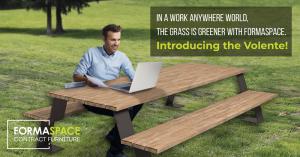How to Create New Outdoor Office Spaces and Outdoor Classrooms
Due to unprecedented demand for outdoor furniture, Formaspace is stepping up production to meet the needs of offices and school facilities.
Quite a few worker satisfaction surveys indicate that people rank access to outdoor views, natural light, and access to nature near the top of their “wish list” for an ideal work environment.”
AUSTIN, TEXAS, UNITED STATES, September 23, 2020 /EINPresswire.com/ -- Across the country, an increasing number of commercial property developers, office facility managers, and school administrators see outdoor spaces as part of the solution for encouraging workers to return to the office for face-to-face meetings or bringing students back on campus for in-person teaching.— Formaspace
Outdoors spaces are perceived as less risky for viral transmission, which helps encourage employees and students to return to work or school campuses with greater confidence.
As public health and architectural historians remind us, today’s renewed focus on fresh air in the Great Outdoors is not a new concept. The 1918-19 Spanish flu pandemic led schools at the time to use outdoor tents as classrooms. It also brought about widespread use of steam radiator boiler heating systems capable of keeping interior spaces warm even when the windows were kept wide-open in the dead of winter, systems that are still in use today in many older buildings.
What’s the best way to get started? We take a look at some of the key considerations for optimizing outdoor office spaces and classrooms.
Choose The Right Site For Outdoor Furniture
Quite a few variables can come into play when choosing where to site your outdoor furniture projects.
In some cases, your site options could be quite limited. For example, take the case of a traditional multi-story urban building, which might only offer the option of kitting out a roof deck or the possibility of carving out space from an adjacent parking lot – but little else short of a major remodel or new construction.
On the other hand, suburban offices and school campuses tend to offer more site options, ranging from converting existing outdoor atriums, patios, or parking lots into office spaces — or setting up outdoor classrooms on school playgrounds, athletic fields, or other outdoor areas on school grounds.
Tip: since the goal of these outdoor offices and classrooms is to create appropriately socially distant workspaces or classrooms, take care to minimize people crowding together at pinch points, such as narrow gates, walkways, or staircases, which defeat the goal of maintaining social distance.
As you evaluate each potential site (assuming there is more than one candidate to choose from), keep tabs on the type of outdoor ground surfaces that are available.
Existing wood decks and concrete or brick patio areas could be put into service fairly quickly by specifying Formaspace mobile outdoor furniture solutions (such as desks, workbenches, or tables) that use industrial-strength casters that can lock into position, yet allow the furniture moved indoors or reconfigured to meet your current needs.
On the other hand, uneven surfaces, such as crushed granite, pebble rock, or grassy areas, can be put to good use for outdoor office areas or classrooms by pouring individual concrete footers that allow your outdoor furniture (specified with flanged feet) to attach securely to the ground.
Blend The Outdoors With The Indoors
Quite a few worker satisfaction surveys (including ones conducted by Formaspace) indicate that people rank access to outdoor views, natural light, and access to nature (such as plants) near the top of their “wish list” for an ideal work environment.
In what may be considered a silver lining in the midst of seriously bad circumstances, the Coronavirus pandemic may help accelerate the recent building design trend popularized by architects, designers, and facility planners: the blending together of indoor and outdoor spaces.
These new energy-saving building designs feature fully functional window openings, movable shade screens, a careful integration of natural plantings (biophilic design) as well as thoughtful transitions between “dis-conditioned” outdoor areas and climate-controlled interiors.
In the years to come, we may look back at the pandemic as the watershed event that helped popularize sustainable building designs that blend the outdoors with the indoors.
Avoid Heat Traps, Wind Tunnels, Sound Echoes
As architects, designers, and facility managers undertake programming (e.g. develop site plan requirements) for new outdoor office and classroom projects, they soon realize there are some key design differences between traditional indoor environments and outdoor facilities.
Design professionals who traditionally work on interior spaces will have to pay attention to new design inputs, such as the path of the sun throughout the day (and over the different seasons).
Quite a few architectural software programs offer solar path calculations, and if you have a choice of where to locate your new outdoor office or classroom, it’s recommended to perform solar analysis to optimize the location – as well as to assist in designing any ancillary structures, such as overhangs or other shading elements, to reduce direct sun exposure. (Workers and students won’t be happy if they get sunburned outdoors or they can’t read their phone or tablet screens due to excessive glare.)
Read more...
Julia Solodovnikova
Formaspace
+1 800-251-1505
email us here
Legal Disclaimer:
EIN Presswire provides this news content "as is" without warranty of any kind. We do not accept any responsibility or liability for the accuracy, content, images, videos, licenses, completeness, legality, or reliability of the information contained in this article. If you have any complaints or copyright issues related to this article, kindly contact the author above.



